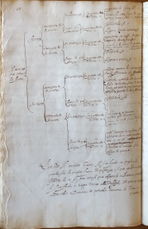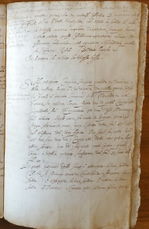|
|
You are not currently logged in. Are you accessing the unsecure (http) portal? Click here to switch to the secure portal. |
Della Scherma (MS 381)
| Della Scherma | |||||
|---|---|---|---|---|---|
| HS 381, Fürstliche Sammlung Palais Liechtenstein Vienna, Austria | |||||
| |||||
| |||||
| Also known as | N-6-15 | ||||
| Type | Fencing manual | ||||
| Date | 1614 | ||||
| Language(s) | Italian | ||||
| Author(s) | |||||
| Scribe(s) | Anonymous | ||||
| Material | Paper, 3 big stitches | ||||
| Size | 53 pages à 330 x 210 mm (height x width) with 30 lines on each page | ||||
| Format | Double-sided, with black ink and pencil | ||||
| Script | Bastarda | ||||
The so called Della Scherma is an Italian fencing manual written in September 1614 by an anonymous author. The original currently rests in the holdings of the fürstliche Sammlung des Palais Liechtenstein in Vienna, Austria.
The book contains 12 sheet of paper and 3 single pages. In total there a 53 pages made out of paper and sewed together in 3 wide (app. 50mm length) stitches. The single pages are the first 3 of the manuscript. The bastard title is made out of 2 sheet of rough cardboard with the texture of blotting paper. It is clotted together with scotch tape made of paper.
On the bastard title there are four different titles written on:
1. in the top left corner: "Scherma" (pencil writing - modern handwriting)
2. in the middle at the top: "Q" (brown ink)
3. in the top right corner: "Vom Fechten" (pencil writing in Bastarda)
4. below the top left corner title: "Fechtkunst in Italien...." (black ink maybe from the 19th or 20th century)
The manuscript contains at least three unknown authors. One of them is the main author who is responsible to the main content of the book. The two others did only marginal notes. One of the "note authors" did write with a pencil and did only make minor notes on the side of the pages, the other one used ink and did sometimes make major changments in the manuscript.
The main authors did start his writing app. 50 mm inside of the left rim but did continue until the very last milimeter of the right side. This brings up some problems in reading the verso side because some text parts are disappearing in the folding of the manuscript.
The water sign is avaiable once on each sheet, which means it is only to be seen on the first half of the manuscript. The sign looks like a heraldic shield with some kind of castle on top of it and a diamond patterned section in the top right and bottom left corner of the shield.
All in all the manuscript is in a fair shape. The edges do look like mice had some fun with it, but the paper is in a good condition and far away from being rotten.



